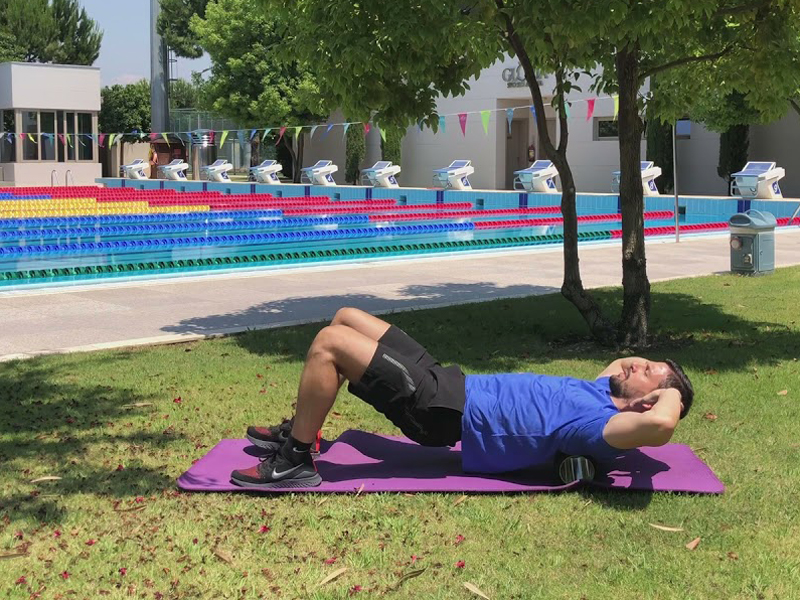4 exercises to improve the thoracic extension
The importance of thoracic mobility for optimal shoulder functioning (Part 1)
Shoulder injury prevention programs designed for swimmers are often focused only on the strength/endurance of the rotator cuff, and the rotational range of the glenohumeral. Though these are important areas to target, the upper body motions involved in swimming are very complex and require contributions from multiple joint segments.
It is important to always consider that the pathoanatomic location of the injury may be the result of limitations proximal or distal to that site. An example would be a swimmer with limited shoulder flexion whose lack of mobility causes them to engage in the compensatory strategy of hyperextending their lumbar region. Though this will help them to achieve an improved streamline during the entry phase of a dive or the underwater kicking phase, it will cause lower back pain which may not immediately be attributed to a shoulder limitation.
One of the areas that swim and strength coaches should be mindful of is the thoracic spine. This is a transitional zone between the cervical and lumbar regions, where approximately 80% of axial rotation originates. Thoracic extension is synchronized with shoulder movement, and thus contributes to the total range of motion during shoulder elevation. Changes in posture and limited range of motion at the thoracic spine can influence the scapula kinematics and could consequently restrict or impair shoulder functioning.

To reduce the risk of injury, it’s important that athletes have a strong base from which to load a movement. An adequate thoracic extension is thus a prerequisite of many exercises performed by swimmers in the gym. Front squats, overheads presses, cleans, snatches, and pull-ups could all potentially overload a compensatory area if an athlete has a limited thoracic capacity.
The following exercises are recommended to strengthen the extension of the thorax. They require attention and precision, as this area is limited in range by nature. An average of 9-15 degrees worth of thoracic spine extension is expected when performing these movements, with more during flexion elevation.
1. Self-massage and thoracic mobilization with foam roller
From the supine position, place the middle of your back on the foam roller with your legs supporting your body weight. Start rolling and massaging the mid-back with slow and controlled movements. Next, cross your arms over your chest, mobilizing the middle of the back while keeping your butt on the floor and strongly contracting your abdomen. Focus on extending your mid and upper back over the roller. Do not arch your lower back and avoid hyperextending your neck (imagine you’re holding a tennis ball under your chin to help). You may add some shoulder flexion movements provided this does not cause your lower back to arch excessively.
2. Lying shoulder flexion with assisted thoracic extension
Lay in the supine position with your lower back flat on the floor and a rolled towel under the thoracic portion of the spine. Grab a stick (though with practice you will be able to perform this exercise without one) and flex your shoulders as far as possible while maintaining postural contact with the floor.
3. Prone sternum lifts
Lay in the prone position on the floor with your arms and elbows flexed to a 90-degree angle. Tuck your chin and lift your head, shoulders and mid-back off the floor without engaging your upper extremities. Avoid extending your entire back, as the movement should be isolated to the contraction of just the thoracic extensors. Hold the contraction for 5-10 seconds, then repeat. You may emphasize the pelvic tilt by contracting your glutes to make sure that your lumbar spine is not extending.
4. Floor slides
While laying on the floor in the supine position with your feet on the floor and your knees flexed, flatten the lumbar region. Bend your elbows at a 90-degree angle, palms facing upwards. Ensuring that your back is not arching off the floor, slide your arms overhead as far as possible while maintaining contact with the floor for the elbows and hands. This exercise can later be progressed by performing it standing against a wall.
Suggested readings:
- N. Heneghan and K. Webb and T. Mahoney and A. Rushton. Thoracic spine mobility, an essential link in upper limb kinetic chains in athletes: A systematic review. Translational Sports Medicine, 2019, 2, 301 – 315
- Ruiz J, Feigenbaum L, Best TM. The Thoracic Spine in the Overhead Athlete. Curr Sports Med Rep. 2020 Jan;19(1):11-16. doi: 10.1249/JSR.0000000000000671. PMID: 31913918.
- Barrett E, O’Keeffe M, O’Sullivan K, Lewis J, McCreesh K. Is thoracic spine posture associated with shoulder pain, range of motion and function? A systematic review. Man Ther. 2016 Dec;26:38-46. doi: 10.1016/j.math.2016.07.008. Epub 2016 Jul 21. PMID: 27475532.
- Hunter DJ, Rivett DA, McKeirnan S, Smith L, Snodgrass SJ. Relationship Between Shoulder Impingement Syndrome and Thoracic Posture. Phys Ther. 2020 Apr 17;100(4):677-686. doi: 10.1093/ptj/pzz182. PMID: 31825488.
- Crosbie J, Kilbreath SL, Hollmann L, York S. Scapulohumeral rhythm and associated spinal motion. Clin Biomech (Bristol, Avon). 2008 Feb;23(2):184-92. doi: 10.1016/j.clinbiomech.2007.09.012. Epub 2007 Nov 5. PMID: 17981379.
- Kebaetse M, McClure P, Pratt NA. Thoracic position effect on shoulder range of motion, strength, and three-dimensional scapular kinematics. Arch Phys Med Rehabil. 1999 Aug;80(8):945-50. doi: 10.1016/s0003-9993(99)90088-6. PMID: 10453773.

Written by:
Marco Cosso
Marco Cosso is an Italian strength and conditioning coach with several years of international experience in sport elite. After graduating in Sport Science he has worked with athletes and amateurs of different level and age. Since 2015 he has worked with the swimming club Energy Standard and coached some of world’s best swimmers including the Olympic medalists Sarah Sjostrom, Chad Le Clos and Florent Manaudou. He is currently living in Turkey where he offers his services at the Gloria Sport Arena performance center.







